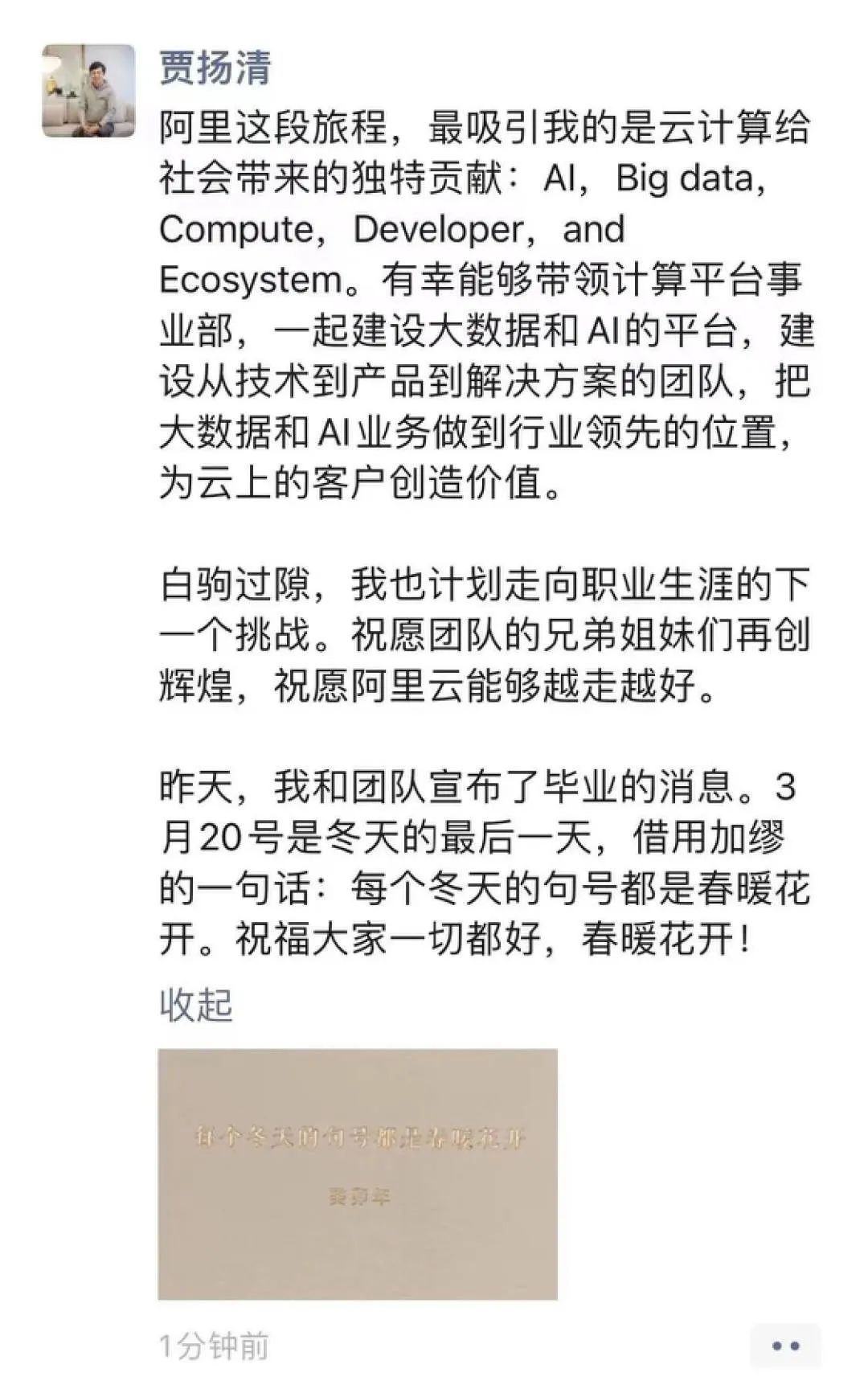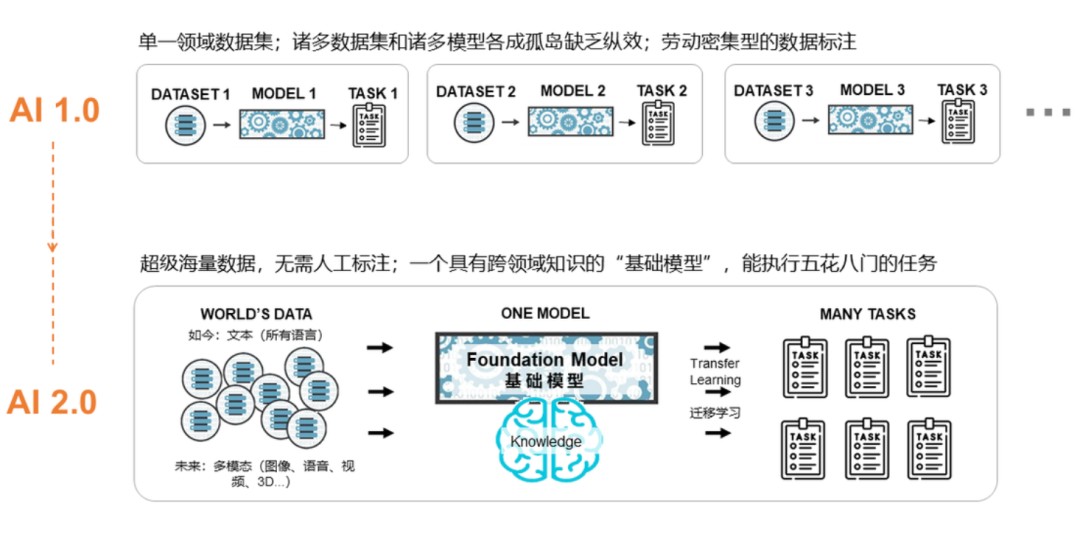AI Large Model Entrepreneurship: In the Battle of Titans, How Can Mortals Seize Opportunities?
-

"Time flies, and I plan to move on to the next challenge in my career."

Image from a social media post
On March 21, Jia Yangqing, Alibaba's technical vice president known as the "top Chinese expert in AI frameworks," announced his resignation on social media, sending shockwaves through the tech community.
Currently, ChatGPT technology is sweeping the globe, rapidly evolving to GPT-4, with OpenAI, its parent company, becoming a rising star and doubling its valuation to become one of the most valuable startups in the U.S. Given Jia Yangqing's career trajectory, his "next challenge" seems evident.
Media reports confirm that Jia Yangqing will venture into entrepreneurship, focusing on the underlying technology of AI large models, including multi-GPU parallel computing, semi-automated AI models, and no-code assembly and training.
Jia Yangqing responded, "Our current plan is to develop the technology and product first, not to raise a large sum of money upfront. At present, there is no need for financing."
From the information revealed, Jia Yangqing is likely to work on AI large model tools.
Jia Yangqing is not the first expert to jump into entrepreneurship on the ChatGPT wave. In February, Wang Huiwen, co-founder of Meituan, posted an "AI Heroes Wanted" notice, stirring the domestic entrepreneurial scene.
Additionally, figures like Kai-Fu Lee (CEO of Sinovation Ventures), Wang Xiaochuan (former CEO of Sogou), Zhou Bowen (former head of JD.com AI), and Li Zhifei (founder of Mobvoi) have joined the ChatGPT-driven entrepreneurial wave, marking the beginning of a new AI startup boom.
Kai-Fu Lee stated, "If AI 1.0 was the invention of electricity, AI 2.0 is the power grid."
The former refers to the AI boom based on deep learning, while the latter represents breakthroughs in foundational large models. Compared to the previous phase, entrepreneurship focused on AI large models now imposes more stringent requirements on technology, funding, and talent, abruptly raising the threshold for AI 2.0 startups.
The gods have taken their positions, and the battle of AI 2.0 titans is about to begin, but it's destined to be beyond the reach of ordinary mortals.
These tech leaders are in a hurry to start their ventures, announcing their entry into the large model race with high profiles, personally promoting their initiatives, and publicly assembling teams.
In February, during a meal with Li Zhifei and two partners from ZhenFund, Meituan's Wang Huiwen issued his first "hero recruitment notice," openly seeking AI R&D talent. In just over a month, Light Year Beyond swiftly launched its Series A funding round, followed by a second "hero recruitment notice" as scheduled.
Perhaps inspired by Wang Huiwen, Zhou Bowen, former head of JD.com's AI division and now founder of Xianyan Technology, also posted a "hero recruitment notice" on his social media.
AI expert Kai-Fu Lee also made a high-profile entry, announcing the establishment of Project AI 2.0 on social media. On the same day, the new company officially launched on the Innovation Works website, posting QR codes to recruit technical talent and researchers in areas like large AI models, multimodal systems, NLP, and Multi-modality, as well as partners interested in AI 2.0-related technologies, scenarios, computing power, and investments.
With ChatGPT's explosive popularity, tech leaders are diving into new ventures, but they're targeting different directions.
A group of experts have vowed to create China's version of OpenAI.
Wang Huiwen posted a "hero recruitment notice" on social media, aiming to build a team for the new era and create China's OpenAI.
Li Zhifei told media that his short-term goal is to develop a 60-point general large model by June next year.
Wang Xiaochuan announced via social media that he would enter the battle to create China's OpenAI and confirmed to media that the project is "in preparation."
Zhou Bowen chose not to imitate OpenAI, stating: "China's OpenAI needs to explore a new path: vertical integration from proprietary foundational large models to applications, forming a closed loop across all user scenarios."
Between the lines, he expressed that his entrepreneurial goal is not to compete directly with OpenAI. Zhou Bowen's future direction is not general-purpose large models but vertical-specific large models.
Kai-Fu Lee stated in his social media circle: "Project AI 2.0 is not just about creating a Chinese version of ChatGPT. AI 2.0 goes beyond being a high-performance chat tool or AIGC content generation. Co-pilot and current applications are merely the beginning of AI 2.0's capabilities."
Lee's ambitions are clearly grander—his startup directly competes with OpenAI, aiming to first develop ChatGPT-like technology and then build applications and ecosystems upon it.
While some dig for gold, others sell shovels. Industry leaders are all exploring opportunities in the ChatGPT entrepreneurial pool. According to incomplete statistics from Light Cone Intelligence, at least nine prominent figures have publicly announced or been reported to have entrepreneurial intentions in this field. Veterans from Meituan, JD.com, and Kuaishou are now facing off in the battle to create "China's GPT."
The entrepreneurial stories of the AI 1.0 era are coming to an end. On the eve of his new venture, Lee proclaimed: "AI 2.0 has arrived, bringing platform opportunities ten times greater than the mobile internet era."
Yin Qi, a graduate of Tsinghua's Yao Class, along with classmates Tang Wenbin and Yang Mu, transformed from students to startup CEOs through a facial recognition game called "Crows Coming," eventually founding Megvii Technology with angel investment.
Huang Wei left Shanda Innovation Institute to establish Unisound, creating technological competition with iFlytek founded by Liu Qingfeng.
Professor Tang Xiao'ou from CUHK accepted tens of millions in investment from IDG Capital, leading over 50 PhDs and postdocs to establish SenseTime.
In 2015, Zhou Xi abandoned his expert position at the Chinese Academy of Sciences to lead a team of facial recognition scientists in founding Cloudwalk.
If AI 1.0 was an opportunity for scientists and engineering experts, AI 2.0 entrepreneurship now demands more than academic credentials—it's a comprehensive battle combining technical prowess and massive capital, becoming a battlefield for industry titans.
These leaders boast impressive backgrounds: graduates from Berkeley, Carnegie Mellon, Tsinghua, and Shanghai Jiao Tong; veterans of Microsoft, Google, Apple, Alibaba, and JD.com. Most have already achieved fame and financial freedom, now pursuing higher entrepreneurial goals.
With such prestigious backgrounds, these new AI model entrepreneurs immediately attract capital. Wang Huiwen's Lightyear Beyond reached a $200 million valuation at launch—such high barriers leave other aspiring entrepreneurs far behind.
However, beyond these differences, the most crucial aspect still comes down to technology.
In the AI 1.0 era, a group of companies emerged, starting with speech recognition and image recognition technologies. Representative companies of the former include iFlytek, Unisound, and AISpeech, while the latter includes SenseTime and Megvii. In the later stages of entrepreneurship, these companies, including the so-called 'AI Four Dragons,' consciously avoided direct competition with rivals and instead focused on more niche sectors such as smart vehicles and healthcare.
These companies quickly rose to become unicorns by excelling in specialized technical fields. However, due to the technological limitations of the time, they faced a significant problem: their solutions were only applicable in limited vertical scenarios, with high costs for R&D, deployment, and operations.
Last year, SenseTime's stock price plummeted by over 50% intraday, wiping out HKD 91.5 billion in market value in a single day. By the end of the year, CloudWalk, which had recently gone public, saw its stock price drop from a high of CNY 36.60 per share to CNY 15.31 per share, with its market value shrinking to CNY 11.3 billion.
Moreover, none of the 'AI Four Dragons' escaped losses. Financial reports show that from 2019 to 2021, the combined losses of these four companies reached CNY 50 billion.
Compared to the AI 1.0 era, AI 2.0 technology can accommodate more scenarios and fields. It is not just about creating a large model for universal application across industries but rather about achieving higher versatility and practicality in vertical scenarios at a lower cost.

Image from Sinovation Ventures' official websiteDespite the enticing prospects, the challenges have increased exponentially. The first hurdle is high computational power, which also translates to high costs.
According to foreign media reports, for example, OpenAI used nearly 1 trillion words and 45TB of data to train GPT-3, with a single training session costing approximately $1.4 million. Additionally, the training and inference costs for large models are exorbitant, with ChatGPT requiring nearly $4.5 million per operation. Nvidia's latest H100 GPU costs $34,000 per card, over CNY 200,000. Creating a ChatGPT-like system would require 30,000 GPUs, costing at least CNY 600 million.
High computational power and costs mean an absolute high barrier to entry in the AI 2.0 era. Without substantial financial backing, it is impossible to bear the expenses of AI training, making early-stage funding crucial.
Previously, star players in the capital market like the 'AI Four Dragons' could only secure financing exceeding tens of millions of yuan after Series B or C rounds. Now, even angel-round financing often reaches tens of millions of dollars, with company valuations soaring to hundreds of millions.
The exorbitant upfront investment costs are beyond the means of ordinary entrepreneurs and companies, coupled with the requirement for absolutely cutting-edge R&D technology. Thus, AI large model entrepreneurship was destined from the outset to be a game only for the titans.
However, money is merely the first and easiest hurdle to overcome in AI large model entrepreneurship.
Faced with uncertain entrepreneurial prospects, talent is an even scarcer resource. When the titans enter the arena, their first battle is to poach top talent.
After all, individuals like Yangqing Jia, who have worked at top tech companies like Google, Facebook, and Alibaba, and led the development of multiple deep learning and AI frameworks, are exceedingly rare. Similarly, figures like Xiaochuan Wang, Zhifei Li, and Bowen Zhou, who possess both technical expertise and years of industry experience, are few and far between.
Likewise, visionary strategic leaders like Kai-Fu Lee and Huiwen Wang, who can accurately gauge technological trends, are hard to come by.
AI large model entrepreneurship requires technology, capital, and talent—all indispensable. The titans armed with these advantages have long left ordinary players far behind. The battle of the gods has no place for mortals.
